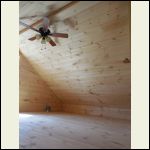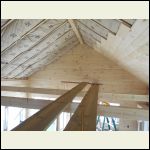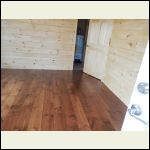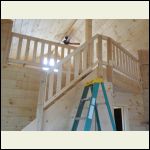|
| Author |
Message |
Shadyacres
Member
|
# Posted: 29 Jan 2014 08:11pm
Reply
I am looking for some input on actual installation of sheetrock in your cabin. What will happen to the drywall with no heat for weeks on end. I talked to a guy with a cabin close to mine and he said his drywall turned black . I don't know if he had painted it or not , also don't know if he had insulation. I am worried if I use it ,( although I will cover it with T & G at some point but it may be a few years till I have it all covered) will it end up getting moldy or damp at the times when I have no heat?
|
|
old243
Member
|
# Posted: 29 Jan 2014 08:24pm
Reply
we used, knotty spruce and pine, for our interior walls. It might not be heated for a month or so at a time. Finished with urethane , looks good. I would think wood might suit better. Can breath better , take on and dissipate any moisture. old243
|
|
Shadyacres
Member
|
# Posted: 29 Jan 2014 08:34pm
Reply
What do you have on the ceiling old243 ? Thanks for the input
|
|
Shadyacres
Member
|
# Posted: 29 Jan 2014 08:36pm
Reply
Also old243 , was your insulation kraft faced and did you place poly besides ?
|
|
toyota_mdt_tech
Member
|
# Posted: 29 Jan 2014 08:41pm
Reply
Zero sheetrock, I also banned OSB too. 
|
|
Shadyacres
Member
|
# Posted: 29 Jan 2014 09:18pm
Reply
toyota_mdt_tech , Why zero sheetrock , because you don't like it ? If I do use it , I will cover it with T & G
|
|
bldginsp
Member
|
# Posted: 29 Jan 2014 09:28pm - Edited by: bldginsp
Reply
Regular gypsum drywall (Sheetrock is actually a brand name) is faced with paper, and the gypsum inside has little if any water resistance, so yes, when its in an unconditioned space during high humidity seasons the paper can mold from moisture and the gypsum can lose integrity. They don't call it drywall for nothing.
Greenboard, or sometimes purple, is not much better if at all. Despite what you may have heard, it isn't waterproof at all and not really even water resistant. My understanding is that the sole purpose of this type of drywall is to withstand the single application of water that comes when tile is applied to greenboard with thinset. That's it, nothing more, and that's only for tile in places other than showers.
There are gypsum boards made that are truly water resistant, such as Densglass or Denssheild, both made by Georgia Pacific. Denssheild is intended as a tile backer in showers, and has a fiberglass facing on it that is waterproof. The gypsum inside is formulated for water resistance, unlike the gyp inside regular gyp board.
Densglass is an exterior grade material with a rough fiberglass surface not intended as a finish surface. Denssheild is not intended as a finish surface either, but its smoother and could function that way.
I plan to use Denssheild for the drywall in my cabin, since it will be unoccupied most of the time and regular drywall would suffer. As well, I plan to use coated decking screws rather than standard drywall screws or nails, to avoid rust. I've seen drywall that was exposed to moisture where the screws rusted and the rust bled through the drywall compound making little rust spots where the screws were.
Denssheild is about $30 a sheet for 1/2".
I also plan to use water resistant bathroom paint throughout. In the little sheds I have on the property, I've seen condensed water literally dripping off the walls during the wet season, so I figure I need a mold resistant paint as well.
|
|
Shadyacres
Member
|
# Posted: 29 Jan 2014 10:02pm
Reply
bldginsp thanks for the info , sounds like you know a lot about drywall. I have heard of denshield but did not locate any in PA. I was going to use the drywall under my T and G . I thought it would help seal the walls, and it may be a while till I get all the T and G up. I am going to use cement board in my shower. If I use kraft faced insulation do you recommend i still use poly ?
|
|
|
MtnDon
Member
|
# Posted: 29 Jan 2014 10:18pm - Edited by: MtnDon
Reply
We have exposed sheetrock on three of the 4 walls. They were primed and painted with 2 coats of high quality paint. That was done in late fall of 2008. We use the cabin an average of twice a month throughout the winter. The cabin is not heated between uses. Winter is cold with temperatures below freezing Dec thru Feb. The daytime highs may hit 40 for a few hours many days, but fall back to 15 to 22 overnight.
When we arrive in winter the interior is below freezing. We heat it to 70 - 75 within a few hours. When we leave it falls into a deep freeze again. Humidity is average, not overly high. In summer with the monsoons we can have weeks of higher humidity. No issues in summer either.
We have had no issues at all with the drywall, or anything else for that matter.
We also have ceramic tile floors installed with thinset over Hardie backer board over the OSB subfloor. Zero problems with that too.
5/8" type X was used.
|
|
toyota_mdt_tech
Member
|
# Posted: 29 Jan 2014 10:19pm
Reply
Quoting: mrhayes toyota_mdt_tech , Why zero sheetrock , because you don't like it ? If I do use it , I will cover it with T & G
I like sheetrock, it just didnt fit my cabin decor. I'm doing rustic, pioneer, western etc.
I sheeted my entire interior with 3/8" plywood.
|
|
rockies
Member
|
# Posted: 29 Jan 2014 10:30pm
Reply
http://www.finehomebuilding.com/assets/downloads/liquid-nails-paperless-drywall.pdf
I think if your drywall is turning black the main problem you should be concerned about is excess moisture within the cabin, whether you're using it at the moment or not. Moisture does not only migrate from the inside out, it also works its way through the wall cavity from the outside in. One way to help prevent condensation problems in the wall is to wrap the exterior of the cabin in 2 sheets of rigid insulation each 1 inch thick and overlap the seams and tape them. This raises the temperature inside the wall cavity so you will have much less condensation of moisture on the interior surface of the exterior sheathing. Also by using a perperless drywall you won't have to worry about mold. I hope this article helps.
|
|
bldginsp
Member
|
# Posted: 30 Jan 2014 12:40am
Reply
mrhayes- don't know about when its best to use or not use kraft faced insulation, or poly or not. I haven't researched it carefully yet, and may not, because the dry climate here in California seems to not require either. Not sure, but I think it's more an issue in places with humid summers. Suggest you spend time on that building science website MtDon recommends, it hopefully explains the how-why-where of it all.
Good luck
|
|
Nirky
Member
|
# Posted: 30 Jan 2014 02:24am
Reply
This topic is one of the reasons I opt for solid wood timber wall construction. No siding, no osb or plywood, thermal mass instead of formaldehyde-laden insulation, no vapor barrier, no drywall. A simple breathable thermal mass wall membrane. And if I stick built, I'd leave out drywall and go with wood.
|
|
turkeyhunter
Member
|
# Posted: 30 Jan 2014 06:00am
Reply
i had drywall installed in dec 2013....in my 19 ft ceiling / and one gable end and knee walls in upstairs bedroom...the drywall guys ( 3 guys installed 22 sheets of 1/2 drywall) another 3 guys came back and mudded the seams/screw dents etc/ another 3 guys came back and sanded and added texture.... the nice white ceiling made it so bright in camp..( which i like) T & G is going in den /kitchen area walls. I did metal ( galvanized tin) in my bedroom ceiling and board batten in mud room walls/ t&G in bathroom ceiling /walls...( forgot they did the ceiling in drywall in mudroom) / and one gable end and knee walls in upstairs bedroom...the drywall guys ( 3 guys installed 22 sheets of 1/2 drywall) another 3 guys came back and mudded the seams/screw dents etc/ another 3 guys came back and sanded and added texture.... the nice white ceiling made it so bright in camp..( which i like) T & G is going in den /kitchen area walls. I did metal ( galvanized tin) in my bedroom ceiling and board batten in mud room walls/ t&G in bathroom ceiling /walls...( forgot they did the ceiling in drywall in mudroom)
I like variety ......
|
|
Shadyacres
Member
|
# Posted: 30 Jan 2014 06:29am
Reply
Thanks everyone for your fine input and advice. Once I get a chance to digest everything I will make a decision on which way I will go. I guess in the end , sounds like most ways will work , just have to make sure it is installed correctly.
|
|
bldginsp
Member
|
# Posted: 30 Jan 2014 08:53am - Edited by: bldginsp
Reply
I'd do a lot of research before covering a wall with polyethylene under drywall or wood T+G. Depending on your circumstances, you could end up trapping moisture inside the wall causing mold, rather than helping the circumstance.
Here's one example of where good intentions with vapor barriers can go awry. In a vaulted ceiling you have to deal with moisture from inside the building getting trapped in and around the insulation that is placed on top of your finish material, which is on top of exposed rafters. So, some people put poly on top of the finish material, under rigid foam insulation. But, if the rigid foam insulation is foil faced, that foil is itself a vapor barrier. What can happen is that moisture that gets above the poly is trapped between it and the foil faced rigid, where it sits, collects, drips, whatever. So in this case you should use the fiberglass faced rigid on top of the poly. I think it's always best to provide an air space above ceiling insulation in a vaulted ceiling, even though it's more work and material.
As I said, I personally haven't studied how moisture is best dealt with in walls, and I think it's largely a function of where you live, what kind of humidity you are dealing with, the temperature differentials. Probably most important is what the humidity levels are at a certain temperature differential- and that will change season to season. Gotta fit your methods to your circumstances.
Only rule of thumb that applies across the board is, 'give the moisture a way out'.
|
|
old243
Member
|
# Posted: 30 Jan 2014 09:44am
Reply
mr, you asked about our ceiling in our camp. From the inside out. We have 2x6 rafters supported on 3- 6x18 fir beams, They are overkill, obtained from a army ammunition bunker. The roof sheeting is 1x8 lumber that we cut on our property. We have a portable sawmill. This is totally exposed. Looks good, this is a hunt camp.
On top of the sheeting . We placed ice and water shield. The roof was then strapped with 2x4 crossways on 24 in centers. 2 inch pink Styrofoam was placed between runs . Steel roofing was placed over this.
We have a fairly steep pitch, as we are in a snowy area and want the snow to slide off. This has worked good for us Old243
|
|
MJW
Member
|
# Posted: 30 Jan 2014 10:12am
Reply
Floor to ceiling 7 inch pine t & g with a couple of coats of poly.
Used it on the floor, too. Just flipped it over. Stain & 3 coats of high gloss.
Ripped it down and built the handrails out of it, too.
DSCN0266.JPG
| 
DSCN0204.JPG
| 
DSCN0413.JPG
| 
DSCN0332.JPG
|
|
|
creeky
Member
|
# Posted: 30 Jan 2014 11:15am
Reply
i recently posted the "perfect wall" system with a link to building science. a site I found some years ago. much to my shame. as I discovered all the stuff I was doing, er, less than optimally.
http://www.buildingscience.com/documents/insights/bsi-001-the-perfect-wall
I believe it was Rockies that posted the link to this site, initially.
http://www.small-cabin.com/forum/7_3836_0.html
this site answers many questions. and the writers generally have a wry and friendly sense of humour. pay particular attention to footnotes.
|
|
dk1393
Member
|
# Posted: 30 Jan 2014 11:56am
Reply
We have 1/2" drywall installed in our cabin. It was done earlier this year. The cabin is not heated in between visits. I have had no problems with it. We did prime and paint as soon as it was up and taped. We are in upstate NY. I also have a friend in NY that has had drywall up in his camp for a few years now. He also has had no problems.
|
|
MtnDon
Member
|
# Posted: 30 Jan 2014 02:21pm
Reply
Quoting: creeky I believe it was Rockies that posted the link to this site, initially.
actually someone named fooboo mentioned the site 11 Jan 2011
and someone named MtnDon mentioned it 9 times since 4 Sep 2012 
|
|
creeky
Member
|
# Posted: 30 Jan 2014 04:11pm
Reply
way to go fooboo.
and I stand corrected. 
|
|
Shadyacres
Member
|
# Posted: 30 Jan 2014 09:25pm - Edited by: Shadyacres
Reply
Thanks again for all the comments . I will probably end up using some drywall , not sure yet. One good thing I hope to do is keep the basement at about 40 degrees over the winter when I am not there and that should keep the floor above from dropping below freezing. I love to look at all the pictures on this forum , trouble is it takes a long time and then I forget where I was at last time I was on.
|
|
missouriboy
Member
|
# Posted: 31 Jan 2014 09:24am
Reply
I also used sheetrock and have had no problems so far. It is painted with good quality paint. The cabin is not heated or cooled between visits. It is the cheapest way to cover walls unless you can get something for free. Like many have said, controlling the moisture is the best way to ensure no problems. Every area of the country is different as to how they insulate so I would go with what others in your neck of the woods do.
|
|
Gpnkn
Member
|
# Posted: 2 Feb 2014 02:01pm
Reply
We are building a cabin on our Little Slice of Heaven on Earth in Northern New Hampshire and the interior will be all wood. We are not using any sheetrock. All pine on the floors, walls and ceilings with various colored stains.
|
|
turkeyhunter
Member
|
# Posted: 2 Feb 2014 08:14pm
Reply
Quoting: Gpnkn Northern New Hampshire
pretty country up in that area...I hope I get drawn for the moose hunt in NH this year....I have as many points as you can have...so I hope it works out!!!! You have moose up at your camp?
|
|
Jim in NB
Member
|
# Posted: 2 Feb 2014 08:42pm
Reply
I choose to use drywall on the walls - painted with a wood celing and eventually I will put in a T&G spruce floor. Lots of glass in the front so the trees are the focus. Love wood but too much of a good thing can distract from the relaxing. The pic is distorted - actually square and not convex
|
|
Shadyacres
Member
|
# Posted: 2 Feb 2014 09:08pm
Reply
Looks good Jim in NB ! I think I will use drywall behind the kitchen cabinets but everything else will be T & G . I will verify with code inspector first , for some reason I thought you had to use Sheetrock for fire rating.
|
|
wirivercabin
Member
|
# Posted: 3 Feb 2014 09:19am
Reply
In the city where I live the inspector made me put up sheetrock before the T&G. I asked why and he did not give me a good answer.. just because that is how they needed it. Don't think he knew for sure.
At the cabin I put the wood right on the ceiling, and sheetrock on the walls. Not heated, but I do try to control moisture, only way I have found in unheated season is to leave a window cracked open.
|
|
Shadyacres
Member
|
# Posted: 3 Feb 2014 04:52pm
Reply
That is what I thought too wirivercabin but when I asked the code office thru email if I needed to install brywall under the T & G boards they responded with I did not need to install drywall but I needed an effective vapor barrier between insulation and wall covering. So that tells me I should be good to go with just T & G. But I will double check so I don't get any surprises.
|
|
|

